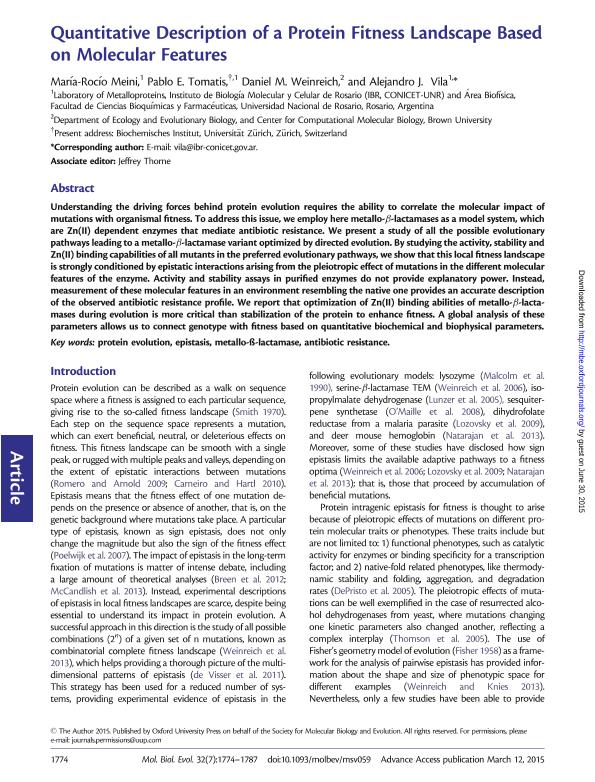Artículo
Quantitative Description of a Protein Fitness Landscape Based on Molecular Features
Fecha de publicación:
03/2015
Editorial:
Oxford University Press
Revista:
Molecular Biology And Evolution
ISSN:
0737-4038
Idioma:
Inglés
Tipo de recurso:
Artículo publicado
Clasificación temática:
Resumen
Understanding the driving forces behind protein evolution requires the ability to correlate the molecular impact of mutations with organismal fitness. To address this issue, we employ here metallo--lactamases as a model system, which are Zn(II) dependent enzymes that mediate antibiotic resistance. We present a study of all the possible evolutionary pathways leading to a metallo--lactamase variant optimized by directed evolution. By studying the activity, stability and Zn(II) binding capabilities of all mutants in the preferred evolutionary pathways, we show that this local fitness landscape is strongly conditioned by epistatic interactions arising from the pleiotropic effect of mutations in the different molecular features of the enzyme. Activity and stability assays in purified enzymes do not provide explanatory power. Instead, measurement of these molecular features in an environment resembling the native one provides an accurate description of the observed antibiotic resistance profile. We report that optimization of Zn(II) binding abilities of metallo--lactamases during evolution is more critical than stabilization of the protein to enhance fitness. A global analysis of these parameters allows us to connect genotype with fitness based on quantitative biochemical and biophysical parameters.
Palabras clave:
Antibiotic Resistance
,
Epistasis
,
Metallo-ß-Lactamase
,
Protein Evolution
Archivos asociados
Licencia
Identificadores
Colecciones
Articulos(IBR)
Articulos de INST.DE BIOLOGIA MOLECULAR Y CELULAR DE ROSARIO
Articulos de INST.DE BIOLOGIA MOLECULAR Y CELULAR DE ROSARIO
Citación
Meini, María Rocío; Tomatis, Pablo Emiliano; Weinreich, Daniel M.; Vila, Alejandro Jose; Quantitative Description of a Protein Fitness Landscape Based on Molecular Features; Oxford University Press; Molecular Biology And Evolution; 32; 7; 3-2015; 1774-1787
Compartir
Altmétricas




